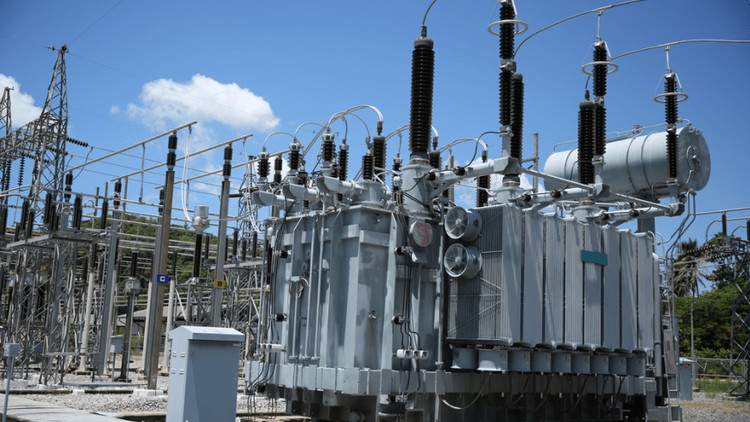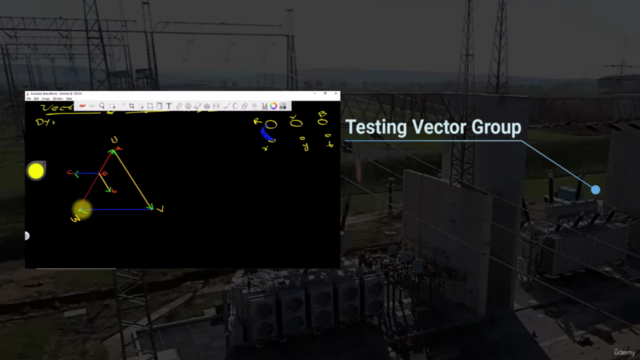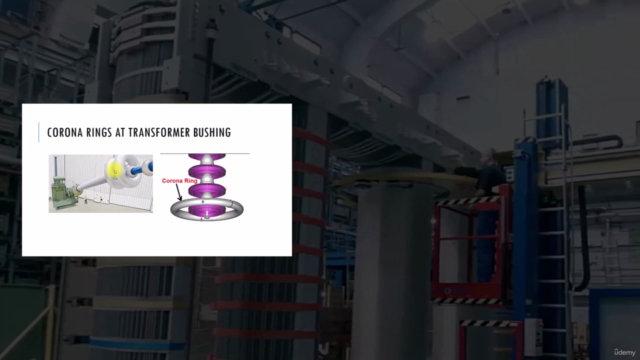Mastering Electrical Transformer Fundamentals Part 6
Learn from Professionals, Electrical Power Engineering

What you will learn
Transformer Name Plate
Transformer General Arrangement Drawing
Vector Group and Clock Method
How to draw winding connection if you know vector group
Testing Vector Group By Voltage Method
Transformer Troubleshooting
Preventive Maintenance of transformer
How Transformers are transported
Corona Rings at transformer bushing
Transformer Fire Protection System
Why take this course?
Hi,
Find below details of topics covered in this training.
Transformer name plate:
Why two / three ratings are mentioned at transformer name plate.
Effect of cooling on transformer rating.
Effect of heating on transformer.
What will happened to transformer rating when one of the cooling systems is faulty?
Transformer short circuit rating.
HV & LV rated currents.
Different cooling methods ONAN, ONAF, OFAF.
What operator need to do if transformer temperature is rising.
IEC standard applicable on transformer.
Selection of ambient temperature for transformer.
How transformers are transported.
Use of Nitrogen during transportation.
Load & No load losses.
Voltages ratios at different taps.
Percentage impedance of transformer.
Base MVA. & Short circuit MVA.
Taping range of transformer.
Vector group of transformers.
How to interpret voltage ratios at different taps, how set tapping at different taps.
Transformer Vector Group, analyzing and explanation.
Bushing CTs location and specifications.
Additive and subtractive polarity of transformer tap changer.
General Arrangement of Transformer: (Drawing is included for self study)
Reviewed the general arrangement of 20-26MVA transformer, top view & side views.
Identified the following components in the GA drawing.
Tank Earthing S.Steel
CT Terminal Box SM2-S
Ladder Steps St 37-2
Oil temperature indicator liquid type
Sludge Opening
Rating Plate
Protective Relay of OLTC MR
Dehydrating breather for OLTC EM2DA
Flanged gate valve DN 25 KITZ
Oil level indicator for Conservator Messko
Oil level indicator for OLTC Messko
Oil temp.ind.with thermo well
Winding temperature indicator
Buchholz relay BR 80 MA
Butterfly Valve
Pressure relief device MR / Messko
Valve DN40,PN10 KITZ
Ventilator / Fan Schormann
Dehydrating breather for transformer
LV Bushing 20 nf 2000
Jacking pad
Marshalling kiosk
Motor-drive unit Messko
HV Bushing (PNO.145.650.800) Passoni.Villa
Rollar wheel
On-Load tap changer MR-Germany
Radiator DIN 42559
Conservator
Tank
Vector Group Philosophy:
Explained the clock method. How vector group are defined using clock methods.
Explained, different vector groups.
Understanding the phase shift.
How to draw three phase connections using just vector group:
Draw the refence star.
Draw delta and star side windings.
Draw HV & LV vectors, using clock methods.
Drawing the connections of DY11 transformer vector group.
You will be able draw all the three phase connections.
I am sure this thing is not explained in any book, I have learned myself in the field.
How to draw vector group of DY1.
Comparing the drawing connection with the connection shown in the name plate.
Testing of transformer Vector Group by voltage method:
In the field now a days automated test sets are used to check the vector group of transformers.
I have explained the method how transformer vector group can be tested by applying just voltage at transformer bushing.
You will be able to test & understand vector group of a transformer by voltage method by applying just voltages.
Transformer trouble shooting:
How to analyze and understand the different signals from a transformer.
What to do when following signals appeared,
Oil level indicator alarm low oil level.
Oil level indicator alarm high oil level.
Oil / Winding high temperature.
Alarm signal of Buchholz relay.
Alarm cooling system.
Trip from pressure relief device.
Differential protection signal.
Transformer Preventive Maintenance:
•Dirt and Dust
•Rust and Treatment
•Check for any Signs of Mechanical Damage
•Check on all Joints for Signs of Leakage
•Check for Oil Level
•Check on the Surrounding Areas
•Checks on Silica Gel Breather
Silica GEL Checks:
In order to prevent severe deterioration of the silica gel, it is recommended that it is replaced when half to two thirds of the silica gel has become saturated and turned pink in color.
Failure to do so will severely retard the drying efficiency of the breather.
The silica gel can be reactivated by heating it to 130°C-140°C in a ventilated oven until it has achieved the bright blue color.
Check that the oil level is correct in the oil cup at the breather base and fill oil if the level is found low.
Do not exceed the temperature stated above otherwise the color impregnation will be destroyed and the silica gel will turn black.
Self-indicating (blue) silica gel contains the dye cobalt chloride which has been classified carcinogenic by a European Commission directive and a banned substance because of its potential health hazards.
An alternative to the blue self-indicating silica gel is SILICA GEL ORANGE with an organic indicator. The color changes from orange to light yellow as it absorbs moisture.
How power transformers are transported?
Heavy Transformers are generally transported in a dismantled state. The main body is transported on HMT while the accessories are transported on high bed trailers and oil drums are transported in trucks.
Nitrogen is basically filled in the transformer during Transport. Oil is normally not filled in Bigger Transformers/Reactors during transit or oil is filled upto core level of the transformer. Nitrogen makes the transformer not to absorb external moisture during transit.
Use of impact recorder.
Use of corona rings used at transformer bushing:
Explained corona rings.
What is voltage gradient.
Effect of corona ring over voltage gradient .
What will happened if corona ring are in designed but not installed at HT & EHT systems.
Water sprinkler system / Deluge valve water system:
In an oil cooled transformer, the oil is likely to catch fire after a certain temperate is exceeded and instantly the entire transformer will catch fire and burn from all sides; even though the transformer is made up of metal. To avoid this, kind fire, we use Water Spray System.
Explained flash point.
What is fire point.
what is Auto ignition temperature.
Deluge valve system.
Nitrogen injection system.
Nitrogen Injection Fire Protection System (NIFPS) prevents oil tank explosion or rapture & possible oil fire in event of minor nature of arcing due to internal faults or external faults (such as failure of condenser bushing of transformer or any other source) in Transformer.
What are different condition and interlocking of nitrogen injection system operation.
Regards
Elite Engineering
Screenshots



